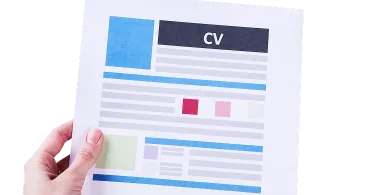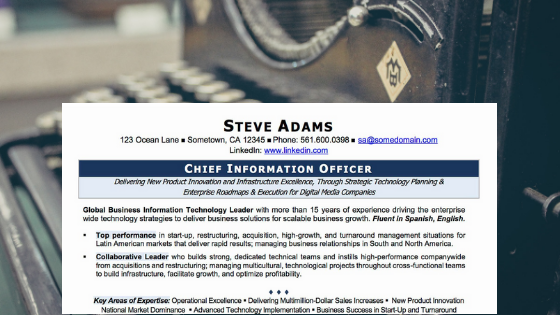Table of contents

The position of a Chief Information Officer (CIO) is now widely accepted as one of the key C-suite roles. The survey results show that 95% of CIOs expect their jobs to change or be remixed due to digitalization.
So, designing a high-impact executive CIO resume can be the difference that can get you in the door. Luckily, IT professional resume writers are ready to share CIO resume writing ins and outs.
When you’re a rock star, things usually fall into your lap. Yet, even the best top tech talents wish to skate through the application process.
It’s a mistake that applicants can’t afford to make in today’s increasingly competitive market. Your resume as a CIO will likely have only a couple of minutes to make a solid impression.
Writing a resume is an unnatural way of talking about ourselves”, said Ivy Exec Career Advisor, Nii Ato Bentsi-Enchill.
Indeed, it’s difficult to write about ourselves objectively and don’t miss the important details of our career that make us stand out.
Well, 26% of CIOs face the growth challenge as the #1 priority for 2018. In fact, your resume is your pitch for why you deserve a promotion. So, your aim is to focus your achievements primarily on revenue growth. Same principles are applied when writing an entrepreneur’s resume.
To get you up to speed, there are some ways to help you win the job search game in 2018. It’s a right opportunity to grab it.
Facing that job descriptions in IT are changing, building and adapting your personal brand can help. Come rain or shine, a personal brand can help build a strong reputation. What’s the secret?
Well, a brand, just like Rome is not built in a day. Nothing comes easy. It takes time and consistency. The first and foremost task is to identify your own core values. What is your response time? What cutting-edge technology do you invest in?
Think about who you are in your professional and personal life, what’s important to you, what excites you intellectually. Be authentic, don’t try to be someone you’re not.

Besides, think of your online reputation. In today’s hyper-connected social media-enabled lifestyle this can be your personal web page, LinkedIn, Twitter or other professional networking profile. Finally, build a network inside and outside your organization, and use it to gain additional support and propel your career.
According to the Harvey Nash CIO UK findings, 76% of CIOs believe good branding promotes closer alignment between their department and the rest of the organization, 60% find that CIO brand allows the CIO’s responsibilities to be extended beyond IT.
Important! Only 24% of the respondents said they were investing the right amount of effort into developing their personal brand.
A great, hard-hitting summary can best establish the focus of chief information officer resume with a good positioning slug. Better yet, it can help provide the reader with a concise picture of the value a CIO offers. In fact, it can help differentiate a top tech talent from everyone else in the market.
Remember, that employers will often make their decision on whether to proceed with a resume by first reading this section. In case it piques interest, the recruiter will continue reading.
A good executive summary is a perfect place to showcase what makes you the perfect candidate. Indeed, it’s not always an easy ride. Yet, it helps establish your executive image and brand.

Look up CIO resume samples that can highlight your most impressive accomplishments and draw recruiters into the rest of your resume.
Even if you have 10 years of experience in the IT field, without specific accomplishments your CIO resume is worth nothing.
As the old saying goes, ‘Do you have twenty years of experience, or one year of experience repeated twenty times?’
A recruiter is a buyer, you are the product. So, you need to give him/her a reason to buy.
A good rule of thumb is that 90% of your resume should be framed as accomplishments. Give tangible, concrete examples in percentages or dollar signs. So, this will make people make more attention.
Express increases in sales, decreases in costs, increases in market share and other changes to an organization’s key performance indicators as percentages or fractions. Say, if you improved customer satisfaction to 90% or if you reduced machinery downtime to 1%, indicating the previous period’s figure.
A hiring manager expects to see specific accomplishments in bullets. Get people to pay attention to your achievements be demonstrating its benefits in a before-&-after format. This is especially important for older professionals (they might want to check resume tips for people over 50).
Based on data compiled by the ‘State of the CIO’ survey and insights from the CIO Executive Council, employers look to categorize candidates. Moreover, CIOs need to have the ability to nimbly switch from one role to another at different times in their careers.
Different businesses need different CIOs.
What type of CIO are you? Are you a Function Head, Transformation Leader, or a Business Strategist?
In fact, the description of experience and accomplishments in your CIO resume will demonstrate what type of CIO you are. Don’t leave recruiters guessing.
Your task is to convey the recruiter in the transition to the new job of CIO easier. Get the employer’s attention and interest him/her in your ‘change-readiness’. You can build trust by doing this.
Also, don’t forget to look through powerful resume action words to make sure your resume can catch the attention of the HR manager!
Write a clear, clean and elegant CIO resume that is easy to read. If you can’t tell a compelling story that fits on one page, two or three pages is fine, but that’s the limit. Add some links to your work which will motivate a recruiter to take an extra step required.
Avoid crammed text or paragraphs that look identical. Get out of weak and vague terms. Don’t get him/her overwhelmed by bullets and walls of text. That should be easy, right?
Instead, add enough white space to help a recruiter keep on reading. Help him/her figure out an entire picture of your experience.
Besides, according to the survey of more than 2,600 CIOs in 256 metropolitan areas in the USA around 17% were removed from consideration because of bad formatting, sloppiness or typos.
So, are you ready to write a well-organized and aesthetically pleasing resume? Whether you write the resume yourself or with the help of a professional, you can’t sit back and wait for offers to roll in. It’s a candidate’s market in technology right now, so, take the plunge. Tin fact, that can aid on your path to the C-suite.